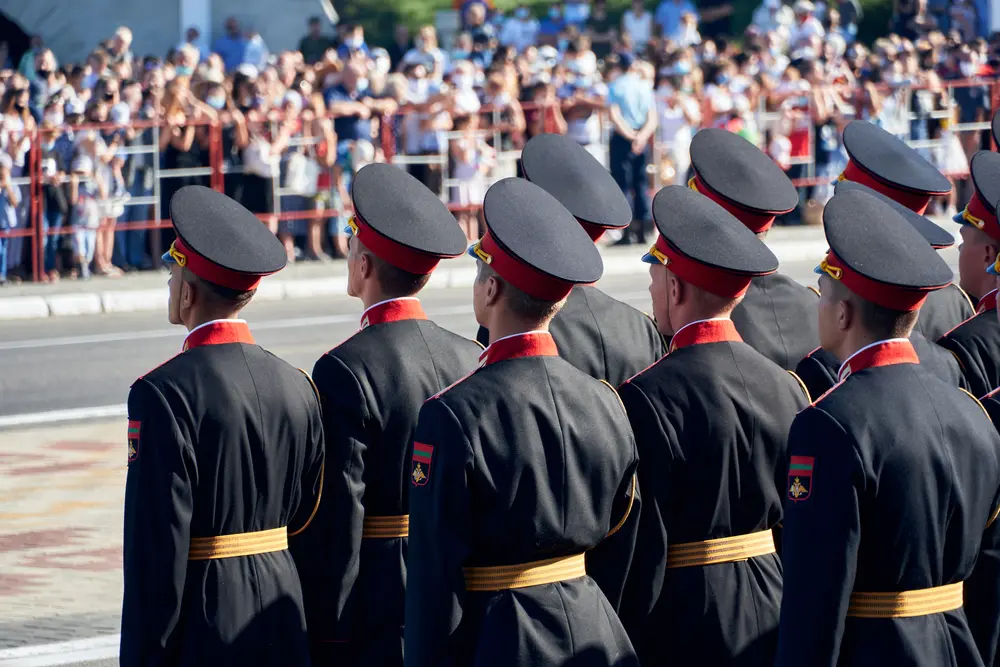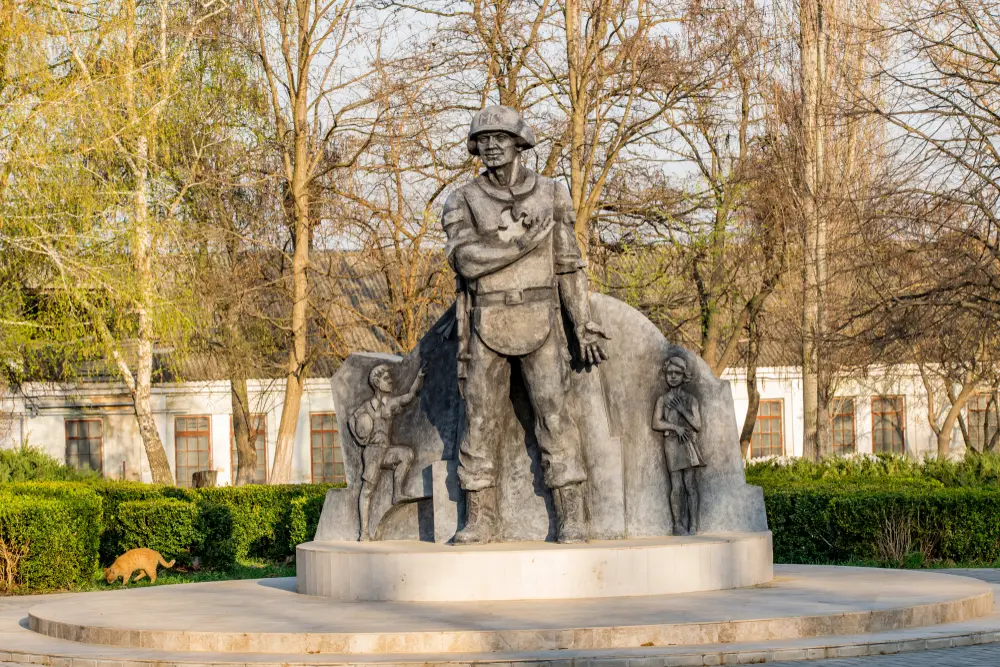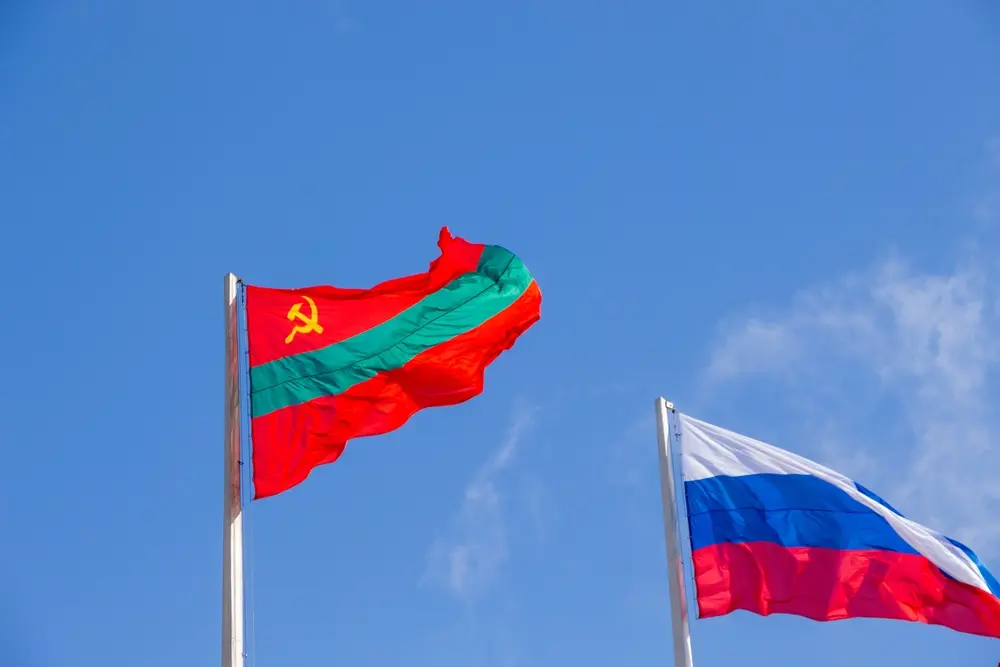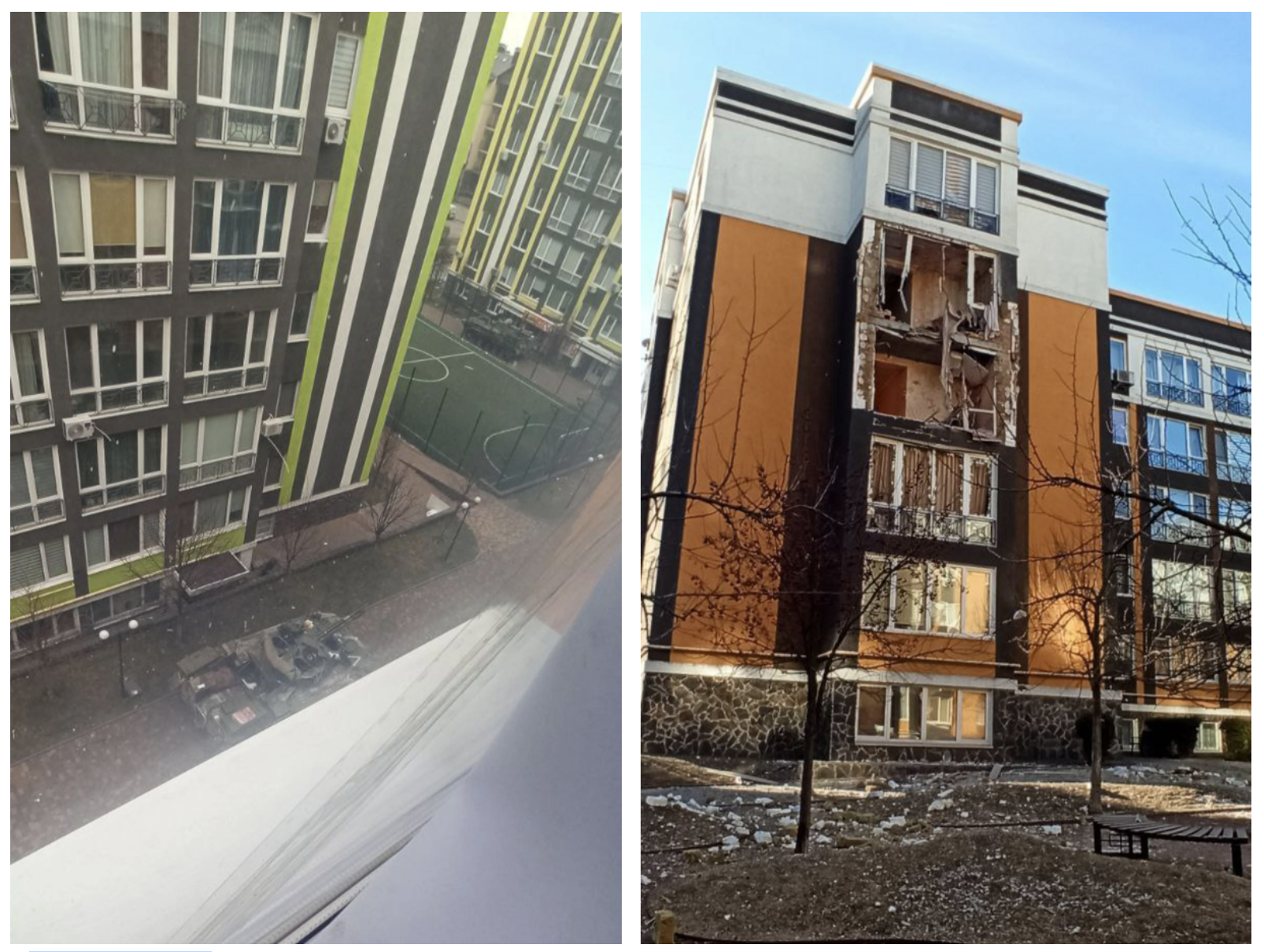
The fact that the war in Ukraine could affect Transnistria became clear as soon as Russia began its invasion. The unrecognized Pridnestrovian Moldavian Republic (PMR) immediately started appearing in the news coverage of the conflict. In February, the Ukrainian Ministry of Internal Affairs said it detained PMR saboteurs. In March, there were reports that missiles were fired from the territory of Transnistria at facilities in Ukraine.
Some of the news was dismissed, some was ignored and later forgotten. At the same time, the Transnistrian authorities kept repeating that PMR did not pose a threat to anyone, had no such plans, and that it was not an enemy of Ukraine.
All of the above was disturbing, but until recently it was perceived as more of an infoshum (info noise) against the background of the firestorm raging in Ukraine. However, since late April, there have been growing signs that the Transnistria conflict, which has been carefully preserved as a frozen one for decades, may suddenly unfreeze.

As a nonprofit journalism organization, we depend on your support to fund coverage of global conflicts. Help us continue funding the hard costs of in-depth coverage of the Ukraine invasion—including travel, hostile environment safety training, and the increased security expenses that arise from reporting in war zones.
Wild April
The chronology is as follows. On April 22, Major General Rustam Minnekaev, deputy commander of the Russian Central Military District, announced that the goal of the second phase of the "special military operation" was to take control of Southern Ukraine — the entire Northern Black Sea region — and to reach Transnistria.
The general was the first Russian military representative and the first official who, for one thing, announced Moscow's plans to essentially deprive Ukraine of access to the sea and, for another, mentioned Transnistria in the context of combat operations. Officially, Russia recognizes PMR as part of Moldova. And the latter is a neutral country.
The general's words predictably caused a scandal: the Russian ambassador to Chisinau was summoned to the Moldovan Foreign Ministry, and Russian Deputy Foreign Minister Andrey Rudenko had to downplay tensions. The diplomat said that the Transnistria conflict should be resolved peacefully, politically, and by taking into account the territorial integrity of Moldova. Thus, he reiterated Moscow's long-standing official position on the Transnistrian issue.
The only problem is that Russian diplomats are not always aware of the real plans of the Kremlin and the Russian military and sometimes learn about said plans after the fact.
That can be illustrated by the situation with the Kremlin's announcement of the decision to recognize the independence of the DNR (Donetsk People's Republic) and LNR (Luhansk People's Republic). Back then, Rudenko said that Russia would recognize them inside the borders within which the republics’ leadership realized their authority and jurisdiction at that moment. Later, Russian President Vladimir Putin said that the republics were recognized within the administrative borders of these two regions, and then gave the order to start the invasion.
Three days after Minnekaev's statement, events began to occur in Transnistria, the likes of which have not been observed here since the 1992 war. On April 25, three unidentified masked men in a car drove up to the building of the Ministry for State Security in the center of Tiraspol, took turns firing rocket-propelled grenades, got into the car, and fled. No one was injured, and no one was caught.
On the night of April 26, it transpired that there was an explosion at an airfield in Tiraspol (the facility was allegedly attacked by a drone). On the morning of April 26, the antennas of a powerful transmitter were blown up in the village of Maiac. No one was injured, and no one was caught.
Finally, on April 27, the news broke about the shooting near the ammunition and weapons storage outside the village of Cobasna near the border with Ukraine. According to various estimates, more than 20,000 tons of ammunition have been stored there since the Soviet era. No one was injured, and no one was caught.
The Transnistrian authorities claimed there was a Ukrainian connection in those occurrences and declared the highest level of a terrorist threat. Russia expressed concern, and Ukraine blamed Russian intelligence services for the provocations.
Oleksiy Arestovich, an adviser to the Ukrainian president's chief of staff, added to the nervousness with his statement that the Ukrainian armed forces can easily (he illustrated the "easily" part by snapping his fingers on the "Feygin.Live" stream) take control of the territory of PMR. Arestovich called recent events in the unrecognized republic a harbinger of a great deal of trouble that Russia is preparing for Moldova. But Kyiv is ready to help and neutralize this threat if Chisinau asks for it.
Then it transpired that Ukraine would hold military exercises near the Transnistrian border — in the vicinity of Cobasna. Military exercises in a country at war do not seem ordinary. Since April 28, one after another, various countries have called on their citizens not to travel to Transnistria under any circumstances and to leave it immediately if they are already there. Such recommendations were issued by Bulgaria, Canada, France, Germany, the U.K., Israel, and the United States.
Finally, on May 1, The Times, citing Ukrainian intelligence sources, wrote that Russia had a plan to invade Moldova. The landing of airborne troops should take place at the Tiraspol airfield, and the Russian military will be delivered from Crimea. The operation will take place before May 9, with the Kremlin allegedly planning to announce the recognition of Transnistria's independence. As The Times noted, Russian planes and helicopters are unlikely to safely pass Ukrainian air defenses. The article also stressed that the claims of the Ukrainian military could not be independently verified.
The first Transnistrian war
The situation in Transnistria has not been this tense since the war ended there 30 years ago and a peacekeeping operation began, involving Russian peacekeeping forces. Speaking of that conflict, during that short but bloody war, Ukrainian nationalists from the UNA-UNSO (Ukrainian National Assembly-Ukrainian People's Self-Defence) fought the Moldovan army and police on the side of the Transnistrian separatists.
Chisinau and Tiraspol, which peacefully coexisted inside one republic during Soviet times, were on the way to an armed confrontation for several years. The friction began in the late 1980s when the Soviet Union started bursting at the seams and intensified as the USSR disintegrated.
A national movement began to gain momentum in many Soviet republics. Moldova was no exception. People began to argue that Moldovan and Romanian were one language and that Moldova and Romania should be reunified because Bessarabia was illegally occupied by Romania.
Such sentiments in Chisinau caused discontent in Tiraspol, where the Russian-speaking population (Russians, Ukrainians, Bulgarians, and Gagauz) prevailed. Large industrial enterprises were concentrated on the left bank of the Dniester River, the territory occupied by today's Transnistria. Tiraspol countered the large-scale Chisinau national movement with a strong labor movement coordinated by the United Council of Labor Collectives.
The contradictions multiplied. If Moldova wanted independence from Moscow, Transnistria was in favor of remaining part of the USSR and even held a referendum on this issue. The unrecognized republic has not formally seceded from the defunct Soviet Union.
Clashes with the use of weapons, but not yet full-fledged military operations, began immediately after the proclamation of the Pridnestrovian Moldavian Soviet Socialist Republic (PMSSR) in September 1990. At first, there were clashes between Moldovan security forces and workers of Transnistrian factories. Then there were clashes between the Moldovan police and the Transnistrian policemen, who refused to stay under the command of Chisinau. The epicenter of the conflict in the first stage was the Dubăsari District and the city of Dubăsari itself.
In 1991, Transnistria created its own guard. They were armed from the arsenals of the Russian 14th Army, created back in 1956. In March 1992, large-scale fighting broke out in Dubăsari, with the use of heavy armor and artillery.
In June 1992, Moldova decided to proceed to a peaceful settlement of the conflict — the Moldovan parliament passed a resolution to this effect, and the creation of a mixed commission was announced to find a compromise. Not only the conflicting parties were involved in the process, but also representatives of Russia, Ukraine, and even Romania.

On June 19, fighting broke out in Bender, and the war flared up again, while Moldovan President Mircea Snegur proclaimed the establishment of constitutional order.
The fighting ended in July. At some point, the 14th Guards Army intervened in the conflict on the side of Transnistria. General Alexander Lebed arrived in the second half of June 1992 to take command of the Army.
Commenting on the situation in Transnistria, he described it as follows: "The shadow of fascism has fallen on this fertile land. I can no longer consider the legally elected president of Moldova, Snegur, to be a president. Yes, he was legally elected at the height of euphoria, but instead of a state leadership, he organized a fascist state, and his clique is fascist."
On Lebed's order, the artillery started firing on the Moldovan positions, which drastically changed the situation on the front. The intervention of the Russian army stopped the conflict. On July 21, 1992, in Moscow, the presidents of Russia and Moldova, Boris Yeltsin and Mircea Snegur signed “The Agreement on principles of peaceful settlement of the armed conflict in the Dniester region of the Republic of Moldova.” According to the agreement, a peacekeeping operation was deployed on the Dniester River with the participation of military contingents of Russia, Moldova, and Transnistria.
The agreement mentioned the issue of withdrawal of the 14th Guards Army from Moldovan territory. However, the situation has not changed in thirty years. What was once the 14th Guards Army has been transformed into The Operational Group of Russian Forces in Transnistria (OGRF) and reduced to about a thousand men. Soldiers of OGRF are engaged to protect the aforementioned weaponry storage in Cobasna. The process of removing the arsenals had been difficult before — even in peacetime, Moscow was in no hurry to liquidate the depots in order to maintain its military presence there. When Russia and Ukraine became openly hostile to each other in 2014, the removal of ammunition, which could not be transported bypassing Ukrainian territory, became simply impossible.
At the same time — in 2014 — the Novorossiya project emerged, which would have provided Russia with access to Transnistria via southern Ukraine. However, the separatist movement in Odesa and the Odesa region did not succeed at that time. But in the context of the current war between Russia and Ukraine, the topic of access to Transnistria arose again. Not only Major General Minnekayev, but also DNR leader Denis Pushilin and the State Duma deputy Alexander Boroday, who actively participated in the events in Donbas in 2014-2015, spoke about it. According to the latter, Russian troops should reach Transnistria.
Limited liability republic
Against the backdrop of the war in Ukraine, Transnistria looks paradoxical. Although the PMR openly demonstrates its pro-Russianness, held a referendum on joining Russia, and Russian tricolored flags are raised all over the republic along with local flags, Tiraspol now prefers not to express its attitude toward the events in the region. Local authorities have not made a single statement in support of the "special military operation," and local public activists have not held a single pro-Russian rally.
The answer to the question as to why this is the case lies not only in the unwillingness to incur the wrath of Ukraine, which pulled its troops closer to the Transnistrian segment of the border with Moldova as a precaution. For all its external pro-Russian sentiments, Transnistria has long ago become an independent economic entity. In fact, this republic is a very pragmatic business project.
The key beneficiary is the limited liability company Sheriff. The company was founded in the early 1990s by Viktor Gushan and Ilya Kazmaly. Both were related to law enforcement agencies. At first, the firm was engaged in trade. The main emphasis was on alcohol and cigarettes, which were brought into the republic from the territory of Ukraine and then were smuggled throughout Eastern Europe and the former Soviet Union.
Later the range of goods expanded, but the scheme remained the same. Goods came to the port of Odesa or Illichivsk (situated a hundred kilometers from Tiraspol) but were not released from bond in Ukraine. They were made out as transit goods and left for Transnistria (sometimes not even the goods themselves, but only a folder with documents for them). Such a procedure made it possible to avoid unpleasant fees. After that, goods were either smuggled or officially distributed, at tax rates of the CIS free-trade zone (Moldova is a CIS member, and Transnistria is a part of Moldova recognized by the world). It was impossible to ensure this specific trade regime without the involvement of Ukrainian authorities. Therefore, one can argue that Ukraine contributed to the formation of the PMR.
Sheriff grew and developed. Today it is a giant holding, controlling dozens of large enterprises. The company is not public, and it is impossible to estimate its turnovers, profit, assets, and other indicators. But it is obvious that the holding is not loss-making. Its controlled enterprises are profitable due to free Russian gas and the electricity generated from it. The gas is conditionally free — the population of Transnistria pays for it, and the money goes to the budget of the unrecognized republic. Russia receives nothing for these supplies. Russian energy company Gazprom just keeps track of the supplies and records the debt to Moldova, which as of last September constituted $7 billion.

Cheap, or rather free, energy allows Transnistrian companies to be competitive, with 69% of Transnistrian exports going to Europe. The Sheriff is so comfortable in such a climate that it can afford to develop quite exotic types of business. For example, on the outskirts of Tiraspol, a gigantic modern complex Aquatir was built, where sturgeons are bred and black caviar is produced (the design capacity of the enterprise is five tons of caviar a year).
Previously Sheriff had to negotiate with the PMR authorities for comfortable conditions for its business, but since 2016, the company managers became the authorities themselves. The current president of Transnistria, Vadim Krasnoselsky, who won the presidential election six years ago and was re-elected again last year, is a protégé of the holding company. He is completely controlled by it and accountable to it. The Transnistrian parliament — the Supreme Council — is also controlled by the Sheriff through the Republican Party "Obnovlenie.” The political system in Transnistria is rather rigid. There are no independent media outlets, it is impossible to work without accreditation, and criminal charges are easily brought against opposition members. Inconvenient candidates are removed from elections, and unsanctioned rallies are not allowed. The regime is not yet Belarussian-level, but it's no longer Moldova or Ukraine in terms of toughness.
Ukraine, by the way, is very important for the business of the holding, both as a market and as a crucial link in the supply chain. After the beginning of the war, Ukraine closed the border with Transnistria and for the first time in its 30 years of existence Transnistria involuntarily got under an uncomfortable dependence on Chisinau: all the goods to the unrecognized republic can be delivered or exported only through the Moldovan territory. Therefore, Tiraspol is not interested in a conflict with Kyiv, especially in an armed one — not only due to the incomparability of military potential but also for economic reasons.
Strange state
Although the Transnistrian authorities have always emphasized their orientation towards Moscow (during the war to a lesser extent), one cannot say that the Sheriff and the local elites would really want to become part of Russia. Such a development would deprive the PMR of the advantages of the current status quo — energy offshore with a special business climate for a select few.
This state of affairs, it must be said, benefits not only Tiraspol but also all those who do business with it in Ukraine, Moldova, and Russia. A few years ago, it was reported that the son of the former Prosecutor General of Russia, Igor Chaika, plans to open mining farms in Transnistria. And energy-consuming mining in the PMR has indeed begun.
For many years, Transnistria has been an example that the unresolved conflict and the status of an unrecognized republic in the absence of hostilities is quite a favorable environment for business. The population of the republic (according to the 2015 census, 475,000 people live in the PMR) has also adapted to this. To ensure freedom of movement, people obtain Ukrainian, Russian, Moldovan, Romanian, and Bulgarian passports in addition to the Transnistrian passport. The latter makes it impossible to travel anywhere. It is not uncommon for the same person to hold two or three citizenships or even the entire listed collection. When war broke out in Ukraine, the number of Transnistrians applying for Moldovan citizenship, which has a visa-free regime with the European Union, increased dramatically.
Overall, the relationship between Chisinau and Tiraspol is a separate case. At first sight, there is conflict and unsolvable contradictions between them. Moldova wants to join the EU and the PMR wants to join Russia. Chisinau talks about territorial integrity, and Tiraspol insists on the final “divorce” and coexistence with Moldova as two independent states.
At the same time, both banks of the Dniester River are firmly connected and, in fact, are a strange form of a common state without a definition. This is neither a federation nor a confederation, but a hybrid entity. Yes, there is a full-fledged border between the parties — Tiraspol has put up customs and border posts along the entire Dniester River. And at the same time, Transnistria enjoys trade advantages enshrined in the agreement with the EU on the creation of a Deep and Comprehensive Free Trade Zone, which was signed by Chisinau and Brussels.

PMR residents travel freely to Chisinau for studies and medical treatment, vote in Moldovan presidential and parliamentary elections, and fly from Chisinau airport. Moldovan residents (though not all, the PMR has blacklists of Chisinau officials) are also free to visit Transnistria. The Tiraspol soccer club Sheriff, which belongs to the holding with the same name, plays in the Moldovan championship, and in European competitions, it plays under the Moldovan flag.
We can say that during the years of unresolved Transnistrian conflict between Chisinau and Tiraspol relations have been established in which they often reach agreements on controversial issues. Especially if these are economic issues or topics related to business.
Reaching a political solution is more difficult. Substantive negotiations on granting Transnistria a special status within Moldova have not been conducted for many years. The last time this subject was seriously discussed was 19 years ago. Then Dmitry Kozak, who at that time was the deputy head of the presidential administration (he holds the same post at the moment), worked together with Chisinau and Tiraspol on a plan for the settlement of the conflict. A document known as the "Kozak Memorandum" was ready by November 2003. It envisioned Moldova becoming a federation, with Transnistria and the autonomous territorial unit Gagauzia as its subjects. The federation would be a neutral demilitarized state with Moldovan and Russian as state languages. At the same time, Russia's military presence was to remain in the republic until 2020.
It was planned to sign the memorandum in the presence of Vladimir Putin who was going to fly to Chisinau for this purpose. A presidential advance team was already in the Moldovan capital when it became known that President Vladimir Voronin of Moldova, who had himself appealed to Putin for help in resolving the conflict, refused to sign the document at the last moment — the night before the signing. The scandal was loud, Putin's visit was canceled, and relations between Chisinau and Moscow were damaged in the long term.
Since then, many in Moldova have been allergic to the word "federation.” But this is not the only reason for the stalemate in the settlement. Moldovan political forces that are oriented to the West, as well as a part of society that supports them, believe that reunification with Transnistria would lead to the risk of a pro-Russian government being permanently established in the entire country. In the small country of Moldova, whose population is already less than three million people, a few hundred thousand pro-Russian voters (and most Transnistrians are just that) could change the electoral balance. Therefore, the current pro-European leadership of Moldova is interested in keeping things as they are. A side effect of the unsettled conflict is that the unresolved problem complicates the European integration of Moldova. And this is to Russia's advantage.
Possible scenarios
One thing can be said for sure now. The war has changed the situation in the region and especially in Transnistria. At the beginning of April, the EU sent questionnaires to Moldova, Ukraine, and Georgia to check their willingness to join the EU. The completed documents have already been handed over to Brussels, and now it is expected to decide on the extent these states meet European standards.
The presence of unresolved conflicts in all three countries is certainly a problem, but given the war in Ukraine, it is difficult to say what the EU's final verdict will be. So far, it is clear that the war has not prevented the granting of questionnaires to these countries, and thus has only accelerated the European integration processes.
This is one side of the situation. The other, the Transnistrian one, is that, depending on the state of affairs on the front, different scenarios for the development of the situation present themselves. One, which was directly stated by Ukraine in the mouth of Oleksiy Arestovich, is to deprive Russia of control over the PMR. This cannot happen in a non-military way, which Arestovich said explicitly. If successful, Kyiv will be able to claim an important military victory over Moscow on the Dniester. Such actions are resisted by Chisinau, which does not want to be dragged into a Russian-Ukrainian war.
Another scenario is possible if one assumes that Russia takes control of the Ukrainian Black Sea region. In this case, Moscow gets the above-mentioned access to the PMR, and then a choice will inevitably present itself: annexing Transnistria and adding it to a hypothetical Odesa People's Republic or taking advantage of the new military and geopolitical reality in the region, or presenting Chisinau with a fait accompli and demanding that the PMR becomes part of Moldova on its terms.
The latter has advantages for Russia. There is an opportunity to gain control over the whole of Moldova through the change of power in Chisinau from pro-European to pro-Russian, with all the ensuing consequences for the European integration. However, it is premature to speculate about such a turnaround: the Russian army could not conquer all of Donbas in two months of fighting, and in the south, it has not yet advanced beyond Melitopol. Therefore, for now, the Transnistrian story is an open-ended one.







